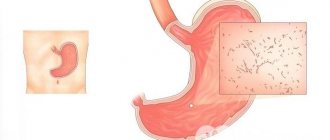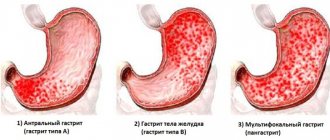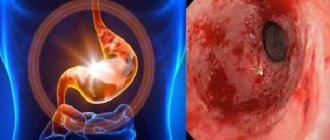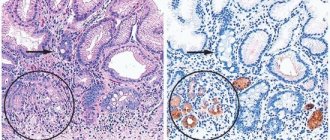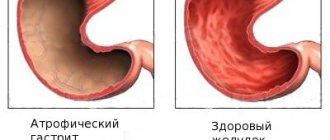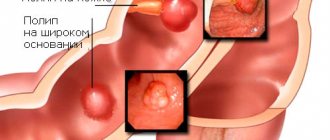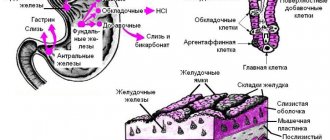Anacidic gastritis (“zero acidity”) is a condition in which the production of hydrochloric acid by the parietal cells of the stomach practically stops.
Against this background, not only the digestive processes suffer, but the protective function of the stomach is also suppressed, and infectious complications arise.
Anacidic conditions often accompany atrophic changes in the mucous membrane, but can also be observed when its structure is normal. This occurs if the nervous regulation of gastric secretion is disrupted.
Functions of hydrochloric acid in the digestive system
There is no exact information about the spread of the pathology, but experts say that in 90% of cases it affects adult patients. The hyperacid form with high acidity is more common, and it is called the initial stage of anacid pathology.
Understanding what anacid gastritis is and how to treat it, you need to become familiar with the functions of acid in the digestive system. The substance is responsible for the normal digestion of food and is indispensable for all processes of the digestive system. When carrying out diagnostics, it is not the quantity, but the intensity of acid synthesis in the basal region that is determined.
It is fixed in pH unit, and the normal value is considered to be the range from 1.5-2 pH. In the initial stages, the indicators may exceed those indicated, which is associated with disruptions in acid production. When a patient drinks a large amount of water in hot weather, the acidity decreases because... it is diluted with liquid.
For the healthy functioning of the stomach enzyme system, it needs an acidic environment. When a bolus of food enters the duodenum, the process of neutralization and a slightly alkaline reaction begins. In different patients, changes in pH values depend on the time of day.
Recommendations for proper nutrition
It is easy to guess that the disease anacid gastritis is much easier to cure if you follow a certain diet. Proper nutrition in general is a panacea for almost all diseases, and even more so those related to the gastrointestinal tract. It is worth paying attention to these recommendations:
- give up fatty, fried and rough foods;
- cook with vegetable or ghee;
- eat every day at the same time and at least 5 times a day, but in small portions;
- if you want a vegetable salad, it is better to boil half of the vegetables and leave the other fresh, because this way the dish will not be too rough, but at the same time it will stimulate the production of digestive juice.
It is recommended to include lean meats such as chicken breast and turkey fillet in your diet. You can prepare cereal or pasta as a side dish, and the bread should be yesterday’s bread at the time of consumption. It is useful to eat fruits and berries, drink milk, herbal infusions, fruit drinks and compotes. For example, you can study treatment table No. 2 according to Pevzner.
What does acid production depend on?
The anatomy of the stomach consists of 2 parts:
- Fundic (bottom and body) - responsible for the production of acid, because it contains synthesizing cells.
- Antral - ensures the neutralization of food lumps with mucus.
If the acid level decreases and the number of parietal cells decreases, important enzymes of the gastrointestinal tract cease to cope with their tasks, and the digestion process is disrupted. The intensity of gastric juice production is determined by the activation of cells:
- In the hyperacid form, the release of digestive enzymes is disrupted, which is accompanied by autoimmune processes, allergies and the inability to digest food.
- When acidity decreases, the stomach cannot produce biochemical active components on which the normal absorption of vitamins and microelements depends. As a result, particles of valuable substances and microelements are removed from the body. This leads to the development of anemia - chemical anemia.
When the level of hydrochloric acid is normal, the gastrointestinal tract disinfects and breaks down food without failure. If it decreases, the processes of rotting and fermentation are started. Pathogenic pathogens that enter through the mouth also multiply in the body.
Similar phenomena are confirmed by an increased number of intestinal infections in the summer, when people drink a lot of water, reducing the content of hydrochloric acid in the stomach.
How dangerous is the disease?
The consequences of the disease can be malignant. Therefore, it is important for patients to know the dangers of hypoacid gastritis. Provoking factors lead to the formation of atrophy of parietal cells that produce hydrochloric acid. A decrease in mucus on the surface of the epithelium leads to a decrease in its protective properties and the colonization of the stomach with pathogenic bacteria. Lack of secretion causes retention of the food bolus and disruption of the breakdown of components. Therefore, toxic breakdown products destroy the epithelium of the stomach.
Due to negative pathogenetic mechanisms, cell degeneration occurs with the formation of intestinal metaplasia. The risk of developing organ tumors increases. Insufficient intake of nutrients leads to protein-energy malnutrition, weight loss, anemia and other complications.
The mechanism of pathology development
Problems with acid synthesis arise due to a failure to adapt the production of the substance in the stomach. Because of this, there are delays in the supply of enzymes and food processing. The biochemical reactions responsible for the digestion of food are severely disrupted, and the patient is faced with severe symptoms, which are used to diagnose the anacid form of gastritis.
Due to the deterioration of protective functions, rough food and toxic substances enter the stomach, which are poorly broken down. When cells are initially overstressed, they die and atrophy. This allows you to determine the picture of gastritis during gastroscopy. Another problem is accompanied by a violation of the following processes:
- Cell restoration.
- Formation of protective mucus.
- Blood supply.
Among the features of hypoacid gastritis are:
- Negative effects on the fundus, which is responsible for normal acid synthesis.
- Rapid transition to the atrophic form.
- Intensive production of the gastrin enzyme due to the accumulation of undigested food.
- Overgrowth of old connective tissue that is not responsible for digesting food.
- Replacement of gastric epithelium with intestinal cells.
Depending on the clinical picture and symptoms, 3 stages of atrophic processes are distinguished:
- Mild - 1/10 of the parietal cells are affected.
- Medium - the degree of damage reaches 10-20%.
- Severe - atrophic processes affect more than 20% of the glandular epithelium.
Diagnostic research methods to confirm the diagnosis
When a doctor suspects chronic anacid gastritis, he prescribes a procedure for the patient, the purpose of which is to determine the level of acidity. For this, a tube with electrodes at the end connected to a special device is used. It is introduced into the patient’s mouth, then gradually moved through the pharynx into the esophagus, and from there into the stomach. During the journey, the device takes readings from the mucous membrane and transmits it to the screen. This procedure is called “intragastric pH-metry”.
Anacidic gastritis is when, according to the results of the study, the pH level fluctuates around 5-6. Other tests are also carried out to clarify the patient’s health status and determine a treatment plan. Among them:
- general and biochemical blood test;
- X-ray of the stomach with contrast agent;
- spinal puncture - this procedure is necessary to determine anemia;
- fibrogastroscopy;
- analysis of stomach contents to identify bacteria;
- biopsy of the gastric mucosa.
Symptoms and course
Hypoacid gastritis is characterized by hidden symptoms for a long time. In the initial stages, the following manifestations are possible:
- Feeling of excessive satiety, heaviness in the epigastric region after each meal.
- Painful sensations after eating, which are localized in the epigastrium.
- Belching with an unpleasant odor.
- Nauseous condition.
- Excessive production of saliva in the mouth.
- Metallic taste.
- Heartburn.
Depending on the nature of the pain, it can be aching or dull. Secondary symptoms include the following:
- Frequent diarrhea and constipation.
- Flatulence and loss of appetite associated with the activity of pathogenic flora and putrefactive processes.
- Rapid hair loss and dry skin.
- Chronic fatigue and general weakness.
- Severe headaches.
- Vulnerability to surges in blood pressure and rapid heartbeat.
- Losing weight.
Some symptoms resemble those that develop in patients with pancreatitis, cholecystitis and dysbiosis.
At the same time, painful sensations due to a deficiency of hydrochloric acid are explained not by contraction of the stomach muscles, but by overstretching of the organ. The pain becomes more severe when eating large amounts of food, eating spicy or fatty foods and sauces. Secondary symptoms are associated with hypovitaminosis and anemia.
Seasonal exacerbations with low acidity are noticed in the spring-autumn period. They are provoked by the abuse of alcoholic beverages, deviation from the dietary regime, or the presence of respiratory infections. Long periods of remission without severe symptoms cannot be ruled out.
Chronic anacid gastritis
What does the gastric mucosa look like in chronic gastritis with low acidity (anacidic)? It is thinned - atrophic, as a result of which its functions decrease, and less and less pepsin and hydrochloric acid are formed, which are so important for digestion.
A number of reasons contribute to the occurrence of anacid gastritis. First of all, systematic overeating, very hot and spicy foods, abuse of alcoholic beverages. Too long breaks between breakfast, lunch and dinner, hasty or dry food, and smoking are also harmful to the stomach.
Most often, chronic anacid gastritis develops after acute gastritis, sometimes after dysentery or typhoid fever. And it can be prevented in all these cases only by correct and timely treatment of these diseases.
Chronic anacid gastritis often accompanies inflammation of the gallbladder and kidneys, chronic enteritis and colitis. It develops mainly in middle-aged and elderly people. What sensations do patients experience? Heaviness, dull pain in the pit of the stomach, belching of food after eating, sometimes nausea, and a tendency to diarrhea is often observed.
These signs indicate a digestive disorder. Indeed, how can a stomach that does not produce sufficient amounts of digestive juices and enzymes cope with its function? No, if you don’t help him significantly - you don’t establish frequent and small meals. IN
Chronic anacid gastritis often accompanies inflammation of the gallbladder and kidneys, chronic enteritis and colitis
Under such conditions, other organs that work cooperatively with the stomach are more actively involved in digestion.
Sometimes, thanks to just the right diet, it is possible to ensure that a person suffering from anacid gastritis can eat the same foods as a healthy person. In such cases, he is prohibited only from spices and hot seasonings.
For exacerbation of chronic anacid gastritis, the following are recommended: stale white bread, white crackers and dry biscuits, vegetarian soups from cereals or vegetables (except cabbage), minced boiled meat or cutlets, soufflé, meatballs, baked steam rolls, boiled fish (in pieces), porridge, puddings, pureed vegetables; whole milk (only in dishes), cream, homemade cottage cheese, mild cheese, soft-boiled eggs or an omelette of two whites and one yolk, sweet fruits without skin, oranges, tangerines, lemon for tea.
Sometimes doctors prescribe medicinal herbs to those suffering from anacid gastritis. They improve intestinal function, reduce gas formation, and calm the nervous system. For this purpose, you can use the following mixture: large plantain, chamomile flowers, mint leaves, immortelle flowers, motherwort.
Spa treatment, especially for older people, is best done in a local sanatorium - gastroenterological or therapeutic, since changing climatic conditions create additional stress on the body. Those suffering from chronic anacid gastritis benefit from everything that strengthens the nervous system. I would especially like to emphasize the importance of timely treatment and dental prosthetics, giving up alcohol and smoking.
Development in childhood
In children's gastrointestinal tract, gastritis manifests itself in an acute form with increased acidity. If symptoms of an anacid state are noticed, a secondary lesion and the cause of the pathology should be found.
In most cases, the inflammation is catarrhal in nature and is not accompanied by atrophy of glandular cells. Timely therapy allows you to restore the functions of the digestive system.
Among the predisposing factors that provoke the disease is an impaired diet, which explains why children often get gastritis in kindergarten or school.
Uncontrolled drinking of soda, eating chips, spicy or fried foods causes irritation of the stomach mucous membranes and leads to gastritis. The following reasons are also taken into account:
- Constant mental disorders and stress.
- Vulnerability to hypoacid conditions before the age of seven due to underdevelopment of the protective functions of the stomach.
- Tendency to infections.
- Unbalanced physical activity in the presence of illnesses.
Among the key symptoms of anacid gastritis in children are:
- Painful sensations in the upper areas of the abdomen, which may vary in intensity.
- Decreased appetite.
- Nausea and vomiting.
- Problems with stool.
- Intolerance to dairy-based foods.
- Fast weight loss.
- Irritable state.
The pathology develops against the background of various chronic infections, lamblia in the gallbladder, allergies to food or medications, as well as neuroendocrine disorders during adolescent development.
A hereditary factor also contributes to the occurrence of the disease.
Treatment
At the first manifestations of anacid gastritis, you will first need to consult a gastroenterologist. The doctor will order certain medical tests to determine the level of acidity in the stomach. If you use medications correctly and follow the instructions of your doctor, you will be able to avoid the development of the disease and normalize the acidity level of the gastrointestinal tract.
Medications
To help the patient, doctors prescribe medications from the following list:
- Pepsidil, Trienzyme. The drugs help replace natural hydrochloric acid.
- Acipepsol, Pentamin. Medicines help restore digestion.
- Smecta, activated carbon. Drugs are prescribed if the patient suffers from diarrhea.
- Guttalax, Senade, Fitomucil are prescribed for constipation.
- Duphalac, Linex, Profibor are probiotics prescribed in case of dysbacteriosis.
Traditional treatment
For the treatment of anacid gastritis, traditional medicine recipes are widely used. Plantain infusion is good for treating illness. In any pharmacy you can find a collection of dry plantain. The leaves are poured with boiling water, left for 10 minutes, filtered and the infusion is drunk throughout the day. It is permissible to consume plantain juice. The plant along with the root must be doused with boiling water and passed through a meat grinder. Strain the juice and boil for 2-3 minutes. Take a tablespoon of infusion daily. The plant helps restore peristalsis and reduces bloating.
This seems to be the case with white cabbage juice. Pass the cabbage through a meat grinder and drink warm half an hour before meals. It is recommended to start treatment with 100 ml daily, increasing the amount to 1 glass per day.
Traditional recipes will definitely give a positive result, it just takes time. After six months, the effectiveness of the chosen method will manifest itself in full force.
It is worth following a diet for any manifestation of gastritis. Avoid fatty, spicy and fried foods. Animal fats that are difficult to digest should not be used in food. It is advisable to cook using vegetable sunflower or olive oil. Consume vegetables, boiled meat, and dairy products. Organize your diet - it is useful to eat in small portions, several times a day.
There is an opinion: if you eat a lot of sour berries and fruits, the acidity level will increase. It's a delusion. When consuming foods, you need moderation.
Characteristics of different shapes
Hypoacid gastritis can occur in various forms and differ in clinical picture and atrophic changes. To determine them, fibrogastroscopy and urine tests are performed.
With superficial gastritis, the intensity of hydrochloric acid production is reduced. The mucous membranes of the stomach begin to thicken, and dystrophy is considered moderate. Increased mucus separation begins.
There are often no obvious symptoms, so the presence of the disease is determined randomly. To prevent the progression of pathology, you need to follow a diet and use folk remedies.
In the case of erosive gastritis, the disease becomes hemorrhagic in nature, which leads to circulatory disorders and vascular changes. The problem occurs due to:
- Long-term therapy.
- Alcohol abuse.
- Crohn's disease.
- Respiratory infections.
In the absence of information about the cause of gastritis, it is called idiopathic.
Medicines have a bad effect on the stomach when taken in large quantities.
The patient may also show signs of bleeding, which are accompanied by:
- Black chair.
- Vomiting with a consistency similar to coffee grounds.
- Dizziness and general weakness.
- Increased heart rate.
The antral form of gastritis is autoimmune in nature or occurs against the background of Helicobacter pylori activity. Atrophy affects the pyloric section of the stomach, and connective tissue destroys the antrum, promoting the transition of the inflammatory process to the intestines.
The exit site of the stomach narrows as tissue swelling and scarring is noticed in this area. Patients experience severe nausea and vomiting.
With acid deficiency, the process of proliferation of mucous tissue and muscle layer starts. This leads to the appearance of tumors and the release of large amounts of mucus. In case of exacerbations, the patient suffers from nausea, diarrhea and pain in the upper regions.
With the polyposis form, the likelihood of the disease developing into a malignant tumor increases.
When transitioning to the acute form, the following complications are possible:
- Problems with the functioning of the digestive organs.
- Pernicious anemia.
- Ulcer and stomach cancer.
- Deterioration of the protective functions of the immune system.
Prevention
To prevent the appearance of anacid gastritis, you just need not to violate the rules of prevention. Eat properly and on time, do not eat food on the go or dry, do not put it off until later, avoid drinking alcohol and tobacco products.
It is important to monitor your daily routine. Lead an active lifestyle and carefully monitor the cleanliness of your mouth. A simple action will strengthen the immune system and nervous system. If you follow the rules, a person will never worry about the symptoms and treatment of anacid gastritis.
Carrying out diagnostics
Based on the clinical picture, it is not easy to separate 2 forms of gastritis: hyper- and hypoacid. Therefore, to make an accurate diagnosis, you will need to carry out tests and hardware examination in the clinic. The patient must undergo:
- Esophagogastroduodenoscopy - the procedure involves the introduction of a special probe to assess the condition of the stomach, duodenum and mucous membranes.
- pH-metry. Involves the use of a special radio capsule or probe.
When biopsy specimens are assessed, it is possible to find not only Helicobacter, but also to estimate its distribution in the mucous membranes.
If probing is not possible, acidity is checked by urine tests and serum gastrin concentrations.
With the help of morphological studies, it is possible to obtain a more detailed clinical picture with determination of the functions of the fundic glands and the intensity of atrophic processes.
The presence of Helicobacter pylori in the blood contributes to the appearance of antibodies in the blood composition. To notice them, you will need to conduct an x-ray examination to identify polypous enlargements, deformities in the antrum, tumors and other disorders. Ultrasound cannot detect such stomach diseases, but other pathologies of the digestive system can be found.
Forecast
Since this disease is chronic, it cannot be completely cured. The main goal of treatment is to stabilize the patient's condition throughout his life. If this is not done, complications that are dangerous to health and life may develop.
Anacidic gastritis can provoke the development of pancreatitis or cholecystitis, anemia, exhaustion of the body, etc. But the most terrible consequence of the disease is stomach cancer.
To avoid such dangerous consequences, it is necessary, when the first signs appear, to contact a medical institution for examination, diagnosis and effective treatment.

